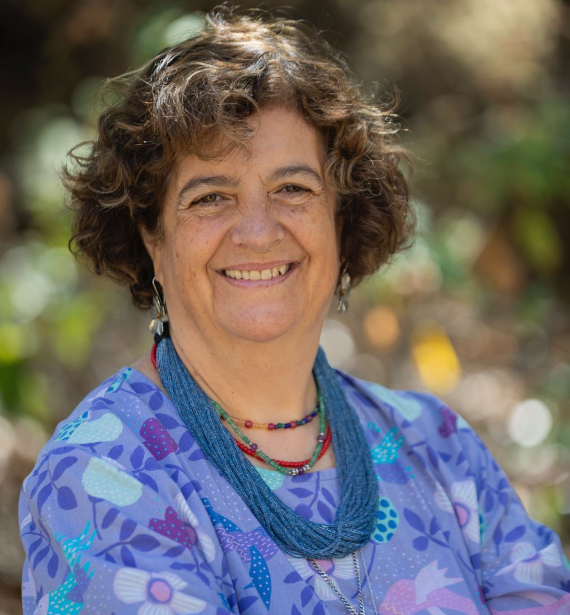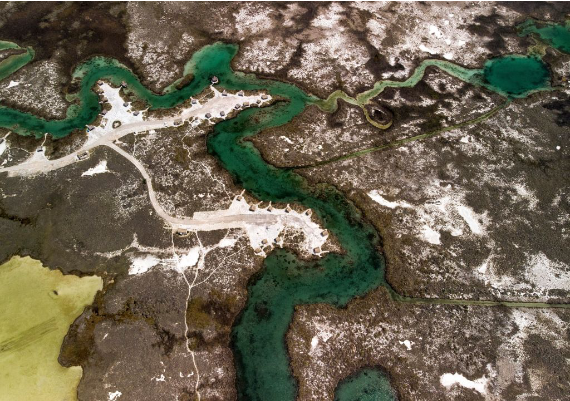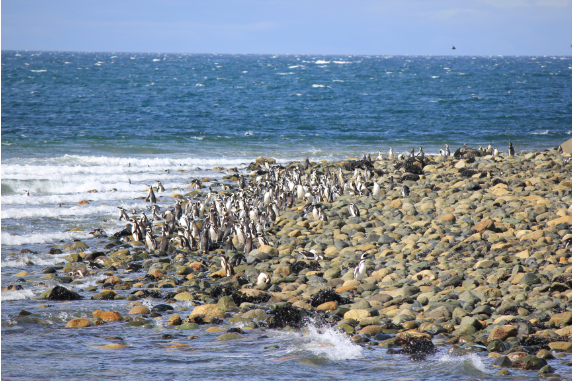Valeria Souza, a researcher at UNAM’s Institute of Ecology, studies the biodiversity and evolution of ancient microorganisms. She has dedicated 23 years of her life to understanding and protecting the richness of the stromatolite-rich pools of the Cuatro Ciénegas Basis (northern Mexico). She has now embarked on a project in the Chilean Antarctic to analyse the microbiome as a bioindicator of the Anthropocene, in particular global warming and ozone depletion.
As a child, Valeria Souza (Mexico City, 1958) could spend hours crouching in her garden, trying to understand the laborious back-and-forth of ants. She was fascinated by biodiversity, the kind that lived in her fertile childhood imagination, like the fairies she looked for when she went into the forest, and the kind that actually lived in the sea when she went swimming. She has worked her way up to her current speciality, microbial evolutionary ecology, in pursuit of a question she first asked herself at the age of 10: “How can DNA—something so simple—hold the key to all living things?” The answer came to her when she read the chapter in a Time Life collection devoted to the fascinating double-helix structure, first discovered and described by James Watson and Francis Crick in 1953.

“From that moment, on I decided to dedicate my life to understanding the secrets…not of ants, fairies or fish, but of DNA,” she recalls. She studied at the National Autonomous University of Mexico (UNAM) for her bachelor’s degree (in biology), master’s degree (in genetics) and doctorate (in ecology). “I found that the answers lay more in ecology and evolution.” This led her to two postdoctoral research positions in evolution with Richard Lenski, one at the University of California, Irvine, and the other at Michigan State University. Lenski is best known for his long-term experiment on the evolution of Escherichia coli, or E. coli, which has been running since 1988.
“I was the academic secretary of my research institute, not because I particularly liked power, but out of a vocation to serve my community. I think this distinction is important.”
“When I was doing my doctoral studies, working with bacteria, I discovered that the translation between DNA and the organism was more direct; this worked more clearly with model species such as Rhizobium, associated with beans (my PhD thesis), or E. coli, associated with wild animals,” says Souza. In 1999, she was invited by NASA to conduct research in the Cuatro Ciénegas Basin, an oasis in Coahuila, northern Mexico. This collection of some 200 small natural pools forms an astrobiological model of the early Earth, in part because of the abundance of stromatolites. “Stromatolites are the oldest fossil evidence on the planet,” says the scientist, dating back 3.6 billion years. “The current ones are made up of complex communities of bacteria in which basically all known metabolisms coexist, so we think that this is where the biogeochemical cycles that govern the planet evolved,” she explains.

She began the project in 2000, thinking that Cuatro Ciénegas would be simple because it is a very phosphorus-poor system. “The micro-organisms cannot be seen, and the ones we can cultivate are just a tiny sample of everything that exists,” says Souza. Even when growing bacterial colonies in petri dishes, it was clear from the start that the diversity was so impressive that the environmental DNA had to be extracted in order to do evolutionary ecology of these communities. In the process, she says, she and her colleagues and students, learned molecular ecology, bioinformatics, genomics and metagenomics. They concluded that Cuatro Ciénegas was not just a simulacrum of primitive Earth “but an actual time machine in which ancestral life was isolated and had evolved, maintaining the functions of the ancestral sea,” she says.
“For me, the real transformative force in society are the high school teenagers, from 15 to 18 years old; they are old enough to understand complex problems and have the energy to take action.”
Her work led to her being made an honorary foreign member of the American Academy of Arts & Sciences in 2019. She was accompanied by her mother (it was her last trip), as well as her husband, Dr Luis Eguiarte, with whom she regularly collaborates (he received the same distinction in 2020), and their children. Souza emphasises how proud her mother was and how important the award is for promoting Cuatro Ciénegas and helping to conserve it. This “diverse paradise,” as she calls it, is seriously threatened by the overexploitation of the aquifers and the draining of wetlands to grow alfalfa.
“That the kids from Cuatro Ciénegas are the Mexican example of the Nagoya Protocol is very exciting, and that one of the kids I taught in 2004 is now a PhD in biotechnology and a leader of this project is even more exciting!“
Souza said goodbye to Cuatro Ciénegas in March 2023, “to give the power of conservation to the landowners,” she argues. The headline in the journal Nature read: “Threatened Mexican oasis loses its main researcher and protector—will it survive?” Meanwhile, she has already plunged into the Sea of the Future. “We have a project at the end of the world, in the extreme south of Chile, in the Strait of Magellan, where, together with CEQUA (Centre for Quaternary Studies of Fuego-Patagonia and Antarctica) in Punta Arenas, we are studying the surface microbiome of two species of penguin, two marine mammals (the humpback whale and the sea lion), two species of fish, two crustaceans and kelp, as a bioindicator of the Anthropocene, in particular global warming and the ozone hole, which has grown alarmingly in the last four years,” she says. The project is funded by Chile’s National Research and Development Agency.

“Understanding the sea of the past has allowed us to conclude that the current sea is sick, because its nitrogen cycle is broken,” explains Souza. Her research is trying to repair it through microbial consortia that possess the genes to process the different steps of the cycle, until it is removed as dinitrogen gas (N2), which is a very stable gas, and not left as nitrous oxide (N2O) or nitric oxide (NO), which are both very reactive and destroy the ozone layer, or as nitrates, which cause eutrophication in bodies of water. Scientists are now testing whether farmed shrimp in Mexico can grow well with such a bacterial consortium, and whether it can prevent disease. “If it works, we can clean up the sea starting with shrimp farms,” she says.
Comments on this publication